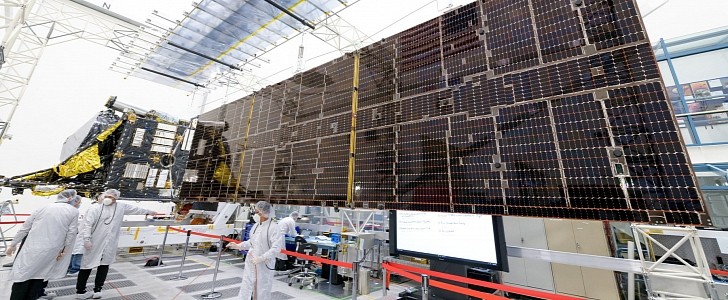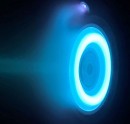NASA's Psyche spacecraft is getting closer to its August launch. A team of engineers has already mounted the massive solar arrays onto the spacecraft. Once deployed in space, the arrays will be about the size of a singles tennis court, helping Psyche complete its 1.5-billion-mile (2.4-billion-km) journey to a rare metal-rich asteroid.
NASA's Psyche spacecraft, which is a little larger than the Smart Car, is preparing for a historical journey to a mysterious metallic asteroid of the same name. To get to it, the spacecraft will harvest the Sun's energy using its massive solar arrays. The 800 square feet (75 square meters) five-panel arrays are the largest ever mounted by NASA's Jet Propulsion Laboratory (JPL) team of engineers.
The arrays will deploy about an hour after launch, providing all of the power needed for the voyage to asteroid Psyche, as well as the electricity required to operate the scientific instruments on board that will help the spacecraft unravel the secrets of the metal-rich rock.
To reach Psyche, which is located in the asteroid belt, the craft will use Mars on its 3.5-year journey for a gravitational push, then spend 21 months progressively shortening its orbit until it gets close enough to study the object.
The solar panels will generate 21 kilowatts near Earth, enough to power three or four average U.S. homes. As Psyche moves farther away from the Sun, the arrays will produce less power. They'll only be able to generate 2 kilowatts at the asteroid, which is only enough to make a hairdryer work.
Scientists thought about these aspects and designed the solar arrays to be durable and provide more power with less sunlight.
"These arrays are designed to work in low-light conditions, far away from the Sun," said Peter Lord, Psyche technical director at Maxar Technologies in Palo Alto, California, where the arrays and solar electric propulsion chassis were built.
After the arrays were installed and deployed one by one inside the JPL's clean room, they were folded back against the chassis and stowed for additional testing. They will be reunited with the spacecraft later this spring at NASA's Kennedy Space Center and then stowed for the big launch, which is set to take place in August, from Cape Canaveral.
The arrays will deploy about an hour after launch, providing all of the power needed for the voyage to asteroid Psyche, as well as the electricity required to operate the scientific instruments on board that will help the spacecraft unravel the secrets of the metal-rich rock.
To reach Psyche, which is located in the asteroid belt, the craft will use Mars on its 3.5-year journey for a gravitational push, then spend 21 months progressively shortening its orbit until it gets close enough to study the object.
The solar panels will generate 21 kilowatts near Earth, enough to power three or four average U.S. homes. As Psyche moves farther away from the Sun, the arrays will produce less power. They'll only be able to generate 2 kilowatts at the asteroid, which is only enough to make a hairdryer work.
Scientists thought about these aspects and designed the solar arrays to be durable and provide more power with less sunlight.
"These arrays are designed to work in low-light conditions, far away from the Sun," said Peter Lord, Psyche technical director at Maxar Technologies in Palo Alto, California, where the arrays and solar electric propulsion chassis were built.
After the arrays were installed and deployed one by one inside the JPL's clean room, they were folded back against the chassis and stowed for additional testing. They will be reunited with the spacecraft later this spring at NASA's Kennedy Space Center and then stowed for the big launch, which is set to take place in August, from Cape Canaveral.










